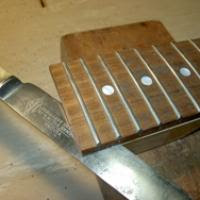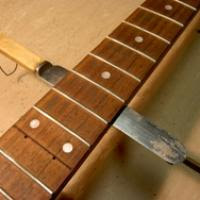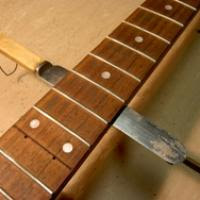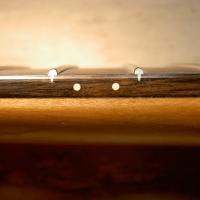Guitar
This week I've had a lot of work on - a Hagstrom in need of re-wiring, a telecaster neck pickup to re-wind, A Les Paul to set up as well as the more run of the mill stuff. But the main job has been to replace the fingerboard on a Fernandes 'Flying V'.






………………………………………………………………………………………….
Feel free to contact me about repair work (if you are in NZ). I only check emails weekly so the workshop phone is always the best 09 307 6501.
- Gibson Lg2 - 1955
This is a beautiful old Gibson guitar from 1955. There's no serial number on some of the less expensive older Gibsons. Instead it has a Factory Order Number. The first letter 'W' tells us the year. This number is not unique to the instrument...
- Music Man Stingray V De-fretting
I got a call the other day from Matt from the Auckland Rockshop - "can I de-fret a Music Man Stingray 5 string Bass for them?" Well in fact he said "what will it cost?". This is a job I do from time to time so I thought I'd write...
- Neck Re-set
A neck re-set is the usually the biggest thing to happen in the life of an acoustic guitar. Over the years the string tension can cause the neck to change its angle to the top and make it impossible to get a lower action. The solution is to take the neck...
- Gibson Es125d Re-fret
This is a continuation of my post describing a re-fret. This nice old Gibson is from 1966 and had such fret and finger board wear that I just had to show you it. The serial number isn't too clear in the photo but its 433265 and according to Gibson's...
- Yamaha Fg-260 12-string
This is a lovely old guitar that came to me with an unplayable action. 12 string guitars often suffer from problems related to string tension and this one had really suffered. The top was bellying and needed the bridge plate replacing - I'll go into...
Guitar
Fernandes 'V' ebony fingerboard
This week I've had a lot of work on - a Hagstrom in need of re-wiring, a telecaster neck pickup to re-wind, A Les Paul to set up as well as the more run of the mill stuff. But the main job has been to replace the fingerboard on a Fernandes 'Flying V'.

The board was rosewood and the customer wanted it changed for ebony. So of course it needed to be re-fretted as well. As this is no doubt very much a ROCK guitar I recomended we fitted high fret wire. I'm very fond of the high narrow wire for this style of instrument. We also decided not to put any marker dots in the face of the board (mainly for looks) as most players don't look at them anyway. Side dots are usually enough. I got a pre made ebony board from an American supplier which had the advantage of already having the fret slots cut in it and a radius. This saves so much time that its worth it. The radius was a little too small for this style of guitar so I had to flatten it a little.

Removing a fingerboard requires a great deal of patience. Boards are always attached with a heat-reversable glue which means that if you warm them up the glue bond will soften an its then possible to coax the board off. The first thing is to plan how the new one will go on in the correct position. To ensure this I remove 12th fret and drill a couple of holes through the fret slot and into the maple of the neck. In these I push two panel pins. I made identical holes through 12th fret on the new board as well. So when the new one goes on I know its located correctly. Now its time to remove the rosewood board.

Firstly I scrape the finish off the sides of the board using a blade. This ensures it won't crack and splinter when I'm taking the board off. I carefully use a heat gun to warm it up. The dots on this one are mother of pearl so they're ok to get hot. If they were plastic I'd mask them so they don't melt. When it feels warm enough (from experience) I ease an oldbutter knife under the board. This is where the patience comes in. You can feel when it wants to come off, push too hard and the wood can split. The warming and pushing can take some time but rushing it here can mean a lot of time spent later cleaning up your mess.

When you're half way through its so tempting to push a little harder and hurry up the job.
When its finally off any glue residue can be cleaned up ready for the new one to go on.
When its finally off any glue residue can be cleaned up ready for the new one to go on.

I use alaphatic resin glue and clamp the neck to a slightly curved caul block to build in a bit of relief to the neck. I find rubber straps give a good even clamping pressure. Any glue that oozes out of the sides when it's clamped I clean off imediately with a damp rag. Its easier to do it when its wet that wait and do it later. The neck is left in this clamping jig for 24 hours. The next stage is shaping the board, re-fretting and putting the side dots in. I'll write about that another time.

Here's the finished job
………………………………………………………………………………………….
Feel free to contact me about repair work (if you are in NZ). I only check emails weekly so the workshop phone is always the best 09 307 6501.
Workshop Hours
Mon……. 8-6
Tues……. 8-6
Wed…….. Closed
Thurs …..8-6
Fri ……….8-6
Sat/Sun ..Closed
Tues……. 8-6
Wed…….. Closed
Thurs …..8-6
Fri ……….8-6
Sat/Sun ..Closed
Mr Glyn’s Guitars
21a Khyber Pass Road
Auckland
New Zealand
http://www.mrglyn.co.nz/
www.facebook.com/MrGlynGuitars
www.mrglyn.blogspot.com
09 307 6501, 021 912678
- Gibson Lg2 - 1955
This is a beautiful old Gibson guitar from 1955. There's no serial number on some of the less expensive older Gibsons. Instead it has a Factory Order Number. The first letter 'W' tells us the year. This number is not unique to the instrument...
- Music Man Stingray V De-fretting
I got a call the other day from Matt from the Auckland Rockshop - "can I de-fret a Music Man Stingray 5 string Bass for them?" Well in fact he said "what will it cost?". This is a job I do from time to time so I thought I'd write...
- Neck Re-set
A neck re-set is the usually the biggest thing to happen in the life of an acoustic guitar. Over the years the string tension can cause the neck to change its angle to the top and make it impossible to get a lower action. The solution is to take the neck...
- Gibson Es125d Re-fret
This is a continuation of my post describing a re-fret. This nice old Gibson is from 1966 and had such fret and finger board wear that I just had to show you it. The serial number isn't too clear in the photo but its 433265 and according to Gibson's...
- Yamaha Fg-260 12-string
This is a lovely old guitar that came to me with an unplayable action. 12 string guitars often suffer from problems related to string tension and this one had really suffered. The top was bellying and needed the bridge plate replacing - I'll go into...
